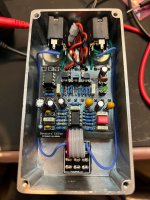Jeff,
I'd like to help with troubleshooting, but first I need to know that you're willing to follow a systematic approach rather than switching parts around at random. Have you cleaned and inspected the board thoroughly? Any parts substitutions?
The LED should be on only when there is a guitar signal present. When the guitar signal gets louder, the LED gets brighter. It will flash during the initial transient and be barely visible otherwise. You have to test in complete darkness if the box is open.
Lets review how this pedal is supposed to work. With this many knobs, it's easy to get lost and some combinations do not work well. That is the price of having maximum control.
The SUSTAIN knob determines the maximum available gain. CW (clockwise) = more gain = more compression. A good initial setting is noon.
The RATIO knob determines how much the AGC (automatic gain control) loop can reduce the gain. CW = more gain reduction = more compression. A good initial setting is 3:00.
The ATTACK knob determines how quickly the AGC loop can reduce the gain during the initial transient. CW = slower response = louder initial transient. A good initial setting is 9:00.
The RELEASE knob determines how quickly the AGC loop can increase the gain after the initial transient. CW = slower response. RELEASE also limits the maximum LED current which might limit how much the ACG loop can reduce the gain. A good initial setting is 10:00.
The operation of the TONE & VOLUME controls is self-evident.
After you have verified that all solder joints are good, all parts are the correct value / part no. and are oriented correctly, we can proceed.
Work your way down this list until the answer is "no." Set ATTACK & RELEASE to 7:00.
If the LED is stuck on when no signal is present, the problem is most likely around Q1-Q3. That doesn't necessarily mean that Q1-Q3 are bad.
With the power off, remove IC1 from the socket and then apply power. Is the LED stuck on?
With the power off, remove Q1 from the socket and then apply power. Is the LED stuck on?
With the power off, remove Q2 from the socket and then apply power. Is the LED stuck on?
With the power off, remove Q3 from the socket and then apply power. Is the LED stuck on?
If you got this far and the LED is still stuck on, then either C10 is shorted internally or there is a solder bridge on the board.




